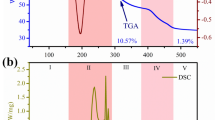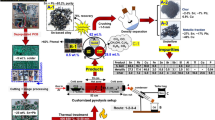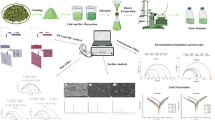Abstract
In the recent years, many studies have been conducted to improve the properties of hybrid silane films, obtained by the sol-gel route, modified with corrosion inhibitors to improve the anti-corrosion properties. The inhibitors obtained from nature (green inhibitors) replace synthetic inhibitors and even rare earth elements (harmful to the environment). Within this approach, this work aims to evaluate the corrosion resistance of the modified TEOS/GPTMS (Tetraethyl orthosilicate/3-Glycidoxypropyltrimethoxysilane) hybrid film with the mixture of the garlic peel and cocoa shell powders as a pre-treatment of SAE (Society of Automotive Engineers) 1008 carbon steel, in which were added different proportions (1:1, 1:2, 2:1) of these mixtures powders, the best mixture ratio was Garlic 1:2 Cocoa. Corrosion resistance was evaluated using electrochemical techniques such as open circuit potential, electrochemical impedance spectroscopy, linear polarization resistance and Tafel polarization curves, in 0.1 mol L−1 NaCl solution. In addition to the scanning vibrating electrode technique, in 0.01 mol L−1 NaCl solution. Film morphology and elements analyses were evaluated by scanning electron microscopy with energy-dispersive spectroscopy. The chemical characterization of the film was obtained by Fourier transform infrared spectroscopy. Physical properties were analyzed by the techniques of contact angle, roughness profile and dry layer thickness. The results of the different techniques indicate that the film modified with the mixture of natural inhibitors has improved anti-corrosive properties compared to the film without natural green inhibitors.
Graphical Abstract

The first image entitled “Garlic peel powder (Allium sativum L.) and Cocoa shell powder (Theobroma Cacao)” shows garlic peel powder (Allium sativum L.) and cocoa shell powder (Theobroma Cacao), both natural inhibitors used in the research, below this first image called “Clean Sample”, is SAE 1008 carbon steel after cleaning the metal surface. The image called “Film solution TEOS/GPTMS with Garlic and Cocoa” is an example of how carbon steel was immersed in the TEOS/GPTMS solution with the inhibitors mixed in different proportions. The image called “Coated steel after curing in a preheater” shows an example of how the sample looked after being cured in a preheated oven, after which they were ready to be evaluated by different techniques. The “Fourier transform infrared spectroscopy (FTIR)” image shows the results of FTIR analysis on the samples. In the image “Scanning electron vibrating technique (SVET)”, it shows the results of the SVET analyzes on the samples. The “Electrochemical Impedance Spectroscopy (EIS)” image shows the results of EIS analyzes on samples. The image “Scanning Electron Microscopy (SEM) with Energy-Dispersive Spectroscopy (EDS)” shows the results of SEM/EDS analysis on the samples.
Highlights
-
Sol–gel route modified with inhibitors to improve anticorrosion performance.
-
EIS diagrams proved that the green inhibitors increase the film resistance.
-
Tafel curves showed inhibitors-silane film presented higher corrosion potential.
-
The film modified with mixture of natural inhibitor has anticorrosive properties.








Similar content being viewed by others
Data availability
The data will be provided on request.
References
Souza KGDAS, Cotting F, Aoki IV et al. (2020) Study of the wettability and the corrosion protection of the hybrid silane (3-aminopropyl) triethoxysilane (APTES) and (3-glycidyloxypropyl) trimethoxysilane (GPTMS) film on galvannealed steel. Rev Mater. 25(2). https://doi.org/10.1590/S1517-707620200002.1063
Capelossi VR, Poelman M, Recloux I et al. (2014) Corrosion protection of clad 2024 aluminum alloy anodized in tartaric-sulfuric acid bath and protected with hybrid sol–gel coating. Electrochim Acta 124:69–79. https://doi.org/10.1016/j.electacta.2013.09.004
Kunst SR, Cardoso HRP, Oliveira CT et al. (2014) Corrosion resistance of siloxane–poly(methyl methacrylate) hybrid films modified with acetic acid on tin plate substrates: Influence of tetraethoxysilane addition. Appl Surf Sci 298:1–11. https://doi.org/10.1016/j.apsusc.2013.09.182
Devikala S, Kamaraj P, Arthanareeswari M et al. (2019) Green corrosion inhibition of mild steel by aqueous Allium sativum extract in 3.5% NaCl. Mater Today Proc 14(2):580–589. https://doi.org/10.1016/j.matpr.2019.04.182
Barreto LS, Tokumoto MS, Guedes IC, et al. (2018) Study and assessment of the efficiency of the cocoa bark extracted from the theobroma cacao as an inhibitor of the corrosion of carbon steel in substitution of benzotriazole. Mater Res. 21(1). https://doi.org/10.1590/1980-5373-MR-2016-0309
da Silva FS, de Melo HG, Benedetti AV et al. (2019) Influence of Ce (IV) ions amount on the electrochemical behavior of organic-inorganic hybrid coatings in 0.1 molL−1 NaCl solution. Eclet Quim 44(4):27–56. https://doi.org/10.26850/1678-4618eqj.v44.4.2019.p27-56
Su H-Y, Che P-L, Lin C-S (2016) Sol–gel coatings doped with organosilane and cerium to improve the properties of hot-dip galvanized steel. Corros Sci 102:63–71. https://doi.org/10.1016/j.corsci.2015.09.019
Montemor MF, Trabelsi W, Zheludevich M et al. (2006) Modification of bis-silane solutions with rare-earth cations for improved corrosion protection of galvanized steel substrates. Prog Org Coat. https://doi.org/10.1016/j.porgcoat.2006.06.009
Hamidon TS, Qiang TZ, Hussin MH (2019) Anticorrosive performance of AA6061 aluminium alloy treated with sol-gel coatings doped with mangrove bark tannins in 3.5 wt% NaCl. Mater Res Express 6(9):09641. https://doi.org/10.1088/2053-1591/ab2ef6
Nikpour S, Naderi R, Mahdavian M (2018) Fabrication of silane coating with improved protection performance using Mentha longifolia extract. J Taiwan Inst Chem Eng 88:261–276. https://doi.org/10.1016/j.jtice.2018.04.017
Peres RN, Cardoso ESF, Montemor MF et al. (2016) Influence of the addition of SiO2 nanoparticles to a hybrid coating applied on an AZ31 alloy for early corrosion protection. Surf Coat Technol 303:372–384. https://doi.org/10.1016/j.surfcoat.2015.12.049
Dariva CG, Galio AF (2014) Corrosion inhibitors: principles, mechanisms and applications. In: Aliofkhazraei M (ed) Developments in corrosion protection. IntechOpen. pp. 365–379. https://doi.org/10.5772/57255
Oracz J, Zyzelewicz D (2019) In vitro antioxidant activity and FTIR characterization of high-molecular weight melanoidin fractions from different types of cocoa beans. Antioxidants 8(560):1–16. https://doi.org/10.3390/antiox8110560
Longhi M, Kunst SR, Beltrami LVR et al. (2015) Effect of tetraethoxy-silane (TEOS) amounts on the corrosion prevention properties of siloxane-PMMA hybrid coatings on galvanized steel substrates. Mater Res 18(6):1140–1155. https://doi.org/10.1590/1516-1439.321614
Barreto LS, Tokumoto MS, Guedes IC, et al. (2017) Evaluation of the anticorrosion performance of peel garlic extract as corrosion inhibitor for ASTM 1020 carbon steel in acidic solution. Rev Mater. 22(3). https://doi.org/10.1590/S1517-707620170003.0186
Casagrande CA, Jochem LF, Repette WL (2020) Analysis of the 3-glycidoxypropyltrimethoxysilane (GPTMS) hydrolysis by infrared spectroscopy. Rev Mater 25(3):1–11. https://doi.org/10.1590/S1517-707620200003.1111
Cotting F, Aoki IV (2020) Octylsilanol and Ce (III) ions – alternative corrosion inhibitors for carbon steel in chloride neutral solutions. J Mater Res Technol 9(4):8723–8734. https://doi.org/10.1016/j.jmrt.2020.06.011
Alibakhshi E, Akbarian M, Ramezanzadeh M et al. (2018) Evaluation of the corrosion protection performance of mild steel coated with hybrid sol-gel silane coating in 3.5 wt.% NaCl solution. Prog Org Coat 123:190–200. https://doi.org/10.1016/j.porgcoat.2018.07.008
Brinker CJ, Scherer GW (2013) Sol-gel science: the physics and chemistry of sol-gel processing. Academic Press, Cambridge, MA
Silverstein RM, Webster FX, Kiemle D (2005) Spectrometric identification of organic compounds. 7th edn., John Wiley & Sons, New York, NY.
Alibakhshi E, Ghasemi E, Mahdavian M, et al. (2017) Fabrication and characterization of layered double hydroxide/silane nanocomposite coatings for protection of mild steel. J Taiwan Inst Chem Eng 1–11. https://doi.org/10.1016/j.jtice.2017.08.015
Boisier G, Pébère N, Druez C et al. (2008) FESEM and EIS study of sealed AA2024 T3 anodized in sulfuric acid electrolytes: influence of tartaric acid. J Electrochem Soc 155:C521–C529. https://doi.org/10.1149/1.2969277
Murase K (1994) Dielectric constant of silicon dioxide deposited by atmospheric-pressure chemical vapor deposition using tetraethylorthosilicate and ozone. Jpn J Appl Phys 33(Part 1, 3A):1385–1389. https://doi.org/10.1143/jjap.33.1385
Acknowledgements
The authors would like to acknowledge to CNPq scholarship – Brazil [National Council for Scientific and Technological Development (grant number: 140187-2017-0)], to CNPq (Process number: 428512/2018-6), to FAPESB (PET0015/2016) and to PROPP/UESC (Pro-Rectory of Research and Post-Graduation at State University of Santa Cruz) for the financial support; to Usiminas S.A. by the SAE 1008 carbon steel; to Klintex Industrial Resources by the alkaline degreaser; to Electrochemistry and Corrosion Laboratory in the Department of Chemical Engineering at the Polytechnique School of the University of São Paulo (LEC/DEQ/Poli-USP, SP, BR) by the scanning electron microscopy with energy-dispersive x-ray spectroscopy (SEM-EDS) analysis, contact angle and roughness measurements and Scanning Vibrating Electrode Technique(SVET) analysis; to BIOMA (Bioenergy and Environment) for FTIR analysis and to the Environmental and Materials Laboratory and the State University of Santa Cruz (LAMMA/UESC, BA, BR) by the support, inputs, and equipment that made this work possible.
Author contributions
The authors’ contributions are as follows: SLBSS: Formal analysis, investigation, methodology, roles/writing – original draft. BPdS: Formal analysis, investigation, roles/writing- review & editing. MST: Formal analysis, investigation, roles/writing- review & editing. FGdF: Conceptualization, supervision. IVA: Roles/writing- review & editing. VRC: Project administration, supervision, funding acquisition, roles/writing – review & editing.
Author information
Authors and Affiliations
Corresponding author
Ethics declarations
Conflict of interest
I, SLBSS, author responsible for the manuscript entitled “Pretreatment of carbon steel with silane film modified with a mixture of garlic and cocoa” and all the co-authors presented here, declare that we do not have any conflict of interest of a personal, commercial, academic, political, and financial in the manuscript. We also declare that all information that could lead to a conflict of interest has already been requested and manifested during the submission process of the aforementioned manuscript.
Additional information
Publisher’s note Springer Nature remains neutral with regard to jurisdictional claims in published maps and institutional affiliations.
Rights and permissions
Springer Nature or its licensor (e.g. a society or other partner) holds exclusive rights to this article under a publishing agreement with the author(s) or other rightsholder(s); author self-archiving of the accepted manuscript version of this article is solely governed by the terms of such publishing agreement and applicable law.
About this article
Cite this article
Santos, S.L.B.S., da Silva, B.P., Tokumoto, M.S. et al. Pretreatment of carbon steel with silane film modified with a mixture of garlic and cocoa. J Sol-Gel Sci Technol 107, 771–782 (2023). https://doi.org/10.1007/s10971-023-06154-2
Received:
Accepted:
Published:
Issue Date:
DOI: https://doi.org/10.1007/s10971-023-06154-2




